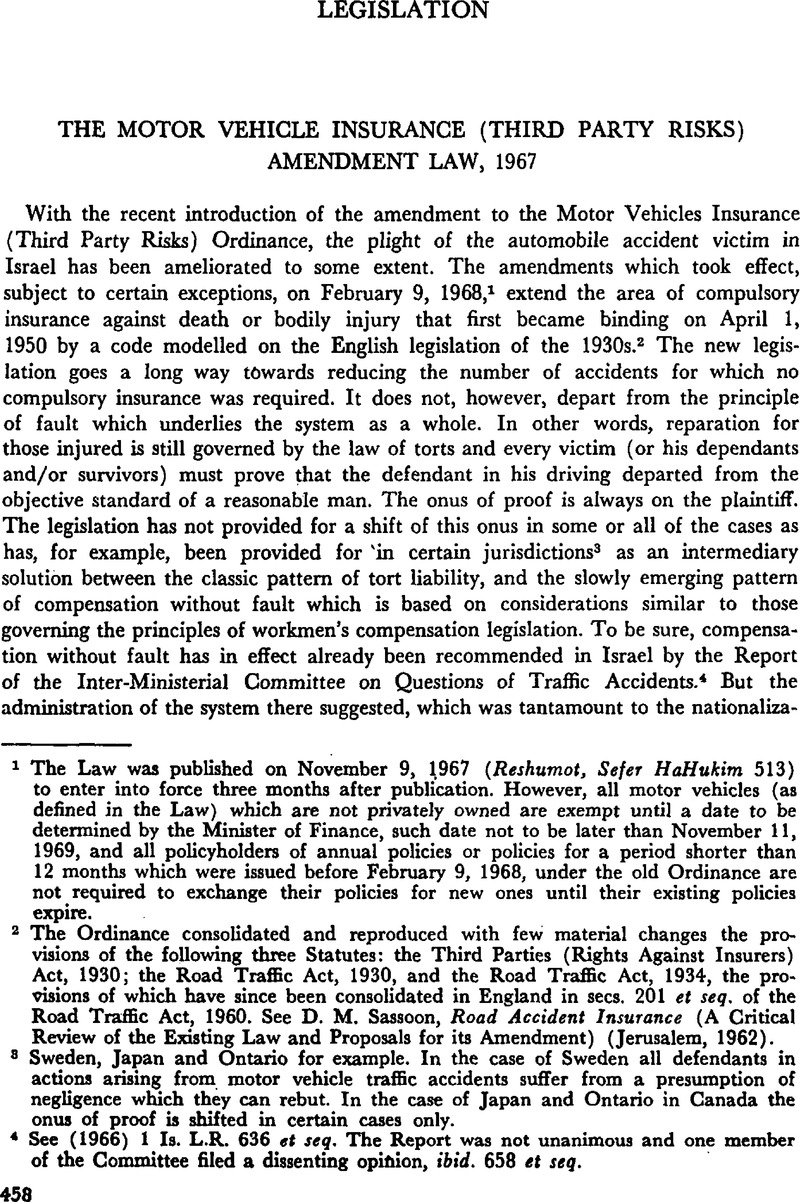No CrossRef data available.
Published online by Cambridge University Press: 12 February 2016

1 The Law was published on November 9, 1967 (Reshumot, Sefer HaHukim 513) to enter into force three months after publication. However, all motor vehicles (as defined in the Law) which are not privately owned are exempt until a date to be determined by the Minister of Finance, such date not to be later than November 11, 1969, and all policyholders of annual policies or policies for a period shorter than 12 months which were issued before February 9, 1968, under the old Ordinance are not required to exchange their policies for new ones until their existing policies expire.
2 The Ordinance consolidated and reproduced with few material changes the provisions of the following three Statutes: the Third Parties (Rights Against Insurers) Act, 1930; the Road Traffic Act, 1930, and the Road Traffic Act, 1934, the provisions of which have since been consolidated in England in secs. 201 et seq. of the Road Traffic Act, 1960. See D. M. Sassoon, Road Accident Insurance (A Critical Review of the Existing Law and Proposals for its Amendment) (Jerusalem, 1962).
3 Sweden, Japan and Ontario for example. In the case of Sweden all defendants in actions arising from motor vehicle traffic accidents suffer from a presumption of negligence which they can rebut. In the case of Japan and Ontario in Canada the onus of proof is shifted in certain cases only.
4 See (1966) 1 Is. L.R. 636 et seq. The Report was not unanimous and one member of the Committee filed a dissenting opinion, Ibid. 658 et seq.
5 Select Committee on Automobile Insurance, Ontario Legislative Assembly, Final Report, March 1963.
6 Through the Motor Insurance Bureau arrangement, a scheme patterned on the English M.I.B. Mention should also be made of the fact that all drivers are able to obtain compulsory cover either through individual insurers or in the case of accident-prone drivers or other unusual risks through a special “pool” arrangement managed by the insurance industry.
7 Lankin, , “Clean-up of Third Party Law”, The Jerusalem Post, January 24, 1968.Google Scholar
8 See Sassoon, ibid., n. 2, at pp. 49 et seq.
a Sec. 4 of the Amending Law.
9 Sec. 70 (a) of the National Insurance Law, 1953, as amended.
10 Sec. 14 (a) (1) of the National Insurance Law, 1953, as amended.
11 Sec. 62 (3) of the Civil Wrongs Ordinance, 1944, as amended.
12 Sassoon, ibid. n. 2, at p. 48.
13 e.g. South Africa, sec. 11 (1) (b) (ii) of the Motor Vehicles Insurance Act, 1942.
13a Sec. 1 of the Amending Law.
14 See Rosenfeld v. A.G. (1957–58) 15 P.M. 12.
14a Sec. 1 of the Amending Law.
15 See Buchanan v. Motor Insurers' Bureau [1955] 1 All E.R. 607.
15a Inter-spouse immunity stems from sec. 9 of the Civil Wrongs Ordinance.
16 See Barnet Group Hospital Management Committee v. Eagle Star Insurance Co. Ltd. [1959] 3 W.L.R. 610.
17 See Zeltner, M., “The Main Changes Introduced by the Law Amending the Motor Vehicle Insurance (Third Party Risks) Ordinance” (1968) 24 HaPraklit 119.Google Scholar
18 See the Barnet case, ibid. n. 16 at 614.
19 There is still no adequate relationship between the revenues raised through the extremely heavy direct and indirect taxation of motor vehicle owners and users and highway expenditures. Revenues from these sources far exceed expenditure on investment in construction of new, and maintenance and improvment of existing roads but the loss of life and limb to the economy caused by bad roads should prove the fallacy upon which the present line of thinking is based.